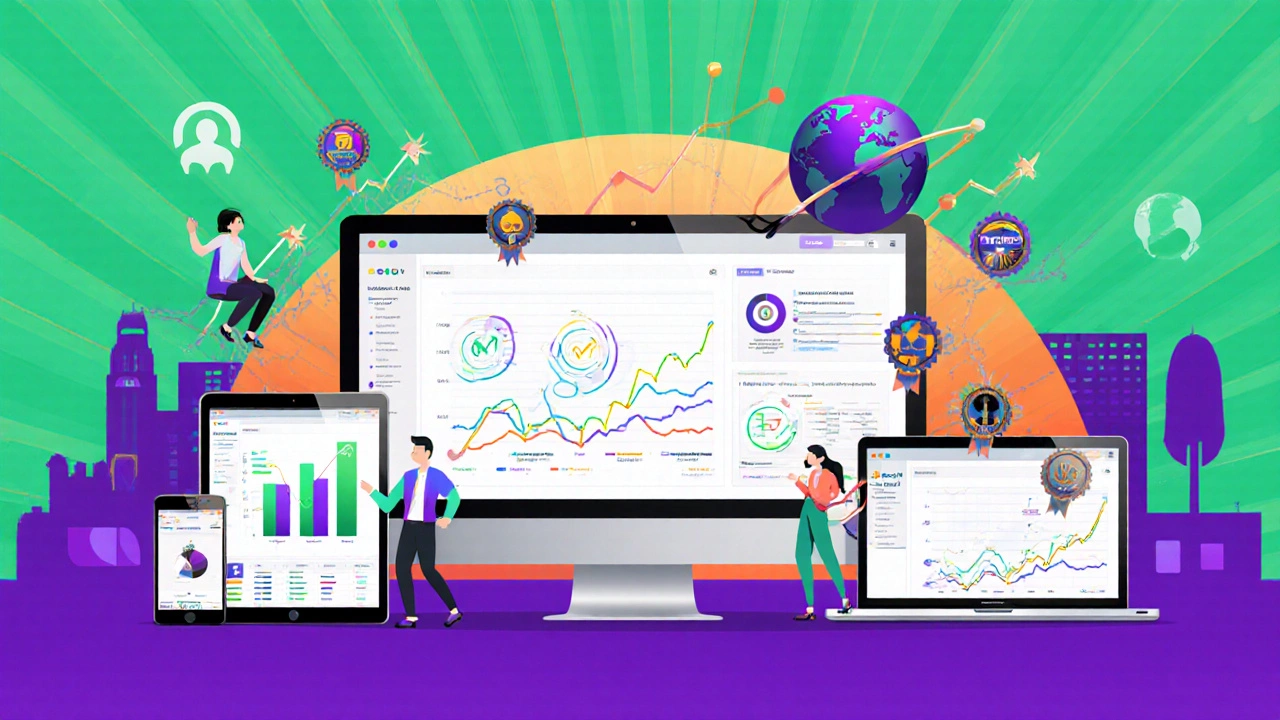Step‑by‑Step Guide to Building an Online eLearning Platform
 Oct, 26 2025
Oct, 26 2025
eLearning Platform Cost Calculator
Estimate Your Monthly Costs
Calculate your estimated monthly expenses for building and running an eLearning platform based on your needs.
Estimated Monthly Costs
Key Considerations
Want to launch a profitable online eLearning platform but don’t know where to start? You’re not alone. Hundreds of educators, entrepreneurs, and training teams face the same question every year. This guide walks you through every decision-from picking the right Learning Management System (LMS) to wiring up payments, video streaming, and gamified quizzes-so you can move from idea to live site without endless trial and error.
Quick Summary
- Define your audience, course structure, and mandatory features before touching code.
- Choose an LMS that matches your budget and customization needs (Moodle, Canvas, or Teachable are solid options).
- Host on a cloud provider like AWS or use managed LMS hosting for scalability.
- Integrate Stripe for payments, Vimeo or YouTube for video, and SCORM compliance for reusable content.
- Test on mobile, run a beta, then roll out with a clear support plan.
What Is an eLearning Platform?
In simple terms, an eLearning platform is a web‑based system that delivers, tracks, and manages digital courses. It houses everything from video lectures and quizzes to certificates and community forums. When you hear the term Learning Management System (LMS), think of the software engine powering that experience.
Plan Before You Build
Skipping the planning stage is the fastest way to waste time and money. Start with these three worksheets:
- Audience Profile: Who are your learners? Professionals seeking certification, K‑12 students, or hobbyists? Define age, tech comfort, and language preferences.
- Curriculum Blueprint: Map out modules, lessons, and assessments. Decide whether you’ll use video, PDFs, interactive labs, or a mix.
- Feature Checklist: List must‑haves (e.g., progress tracking, discussion boards, gamification) and nice‑to‑haves (AI‑driven recommendations, live webinars).
Having these documents lets you match technical choices to real needs, rather than buying features you’ll never use.
Pick the Right Technology Stack
Three decisions dominate the stack: hosting, LMS software, and auxiliary services.
- Hosting: For maximum control, provision a virtual server on AWS (Amazon Web Services). If you prefer a hands‑off experience, many LMS providers offer managed hosting.
- LMS Options: Below is a quick comparison to help you decide.
- Auxiliary Services: Payment gateway (Stripe), video CDN (Vimeo or YouTube), and content standards (SCORM).
| Feature | Moodle | Canvas | Teachable |
|---|---|---|---|
| Open‑source | Yes | No (hosted SaaS) | No (hosted SaaS) |
| Initial Cost | Free (self‑hosted) | Free trial, then $9‑$15/user/month | $39‑$299/month |
| Customization | High - plugins, PHP code | Moderate - API & LTI | Low - limited styling |
| Scalability | Depends on your server | Cloud‑native, auto‑scale | Cloud‑native, auto‑scale |
| Built‑in E‑commerce | Via plugins (e.g., PayPal, Stripe) | Via integrations | Native checkout |
Setting Up the Core LMS
Below is a concise walk‑through for the most popular open‑source choice, Moodle. The steps are similar for Canvas or Teachable, minus the server work.
- Spin up an Ubuntu 22.04 instance on AWS (t3.medium is a good starting point).
- Install required packages:
sudo apt-get update && sudo apt-get install -y apache2 mysql-server php php‑xml php‑gd php‑curl php‑mbstring. - Create a MySQL database named
moodleand a dedicated user. - Download the latest Moodle zip from moodle.org, extract to
/var/www/html/moodle, and set proper permissions. - Run the web installer by visiting
http://your‑domain.com/moodleand follow the on‑screen wizard (language, database, admin account). - After installation, log in as admin and enable HTTPS via Let’s Encrypt (
sudo certbot --apache -d your‑domain.com).
Once the base LMS is live, you can add plugins for quizzes, certificates, and gamification.
Essential Integrations
Even the best LMS feels half‑baked without a few key services.
- Payments: Use Stripe for credit‑card processing. Most LMS plugins offer a Stripe webhook that automatically grants course enrolment after payment.
- Video Hosting: Host large video files on Vimeo Pro or use YouTube’s unlisted mode for free bandwidth. Embed via
<iframe>and enable adaptive streaming. - SCORM Compliance: If you already have SCORM packages, install the Moodle “SCORM package” activity. It tracks scores, completion, and time‑spent automatically.
- Gamification: Add a badge system with the “Level Up!” plugin, or integrate with BadgeOS for custom achievements.
Designing a Learner‑Friendly UI
A clunky interface kills engagement faster than a bad lecture. Follow these design heuristics:
- Responsive Layout: Use a CSS framework like Tailwind or Bootstrap so courses look great on phones, tablets, and desktops.
- Clear Navigation: Keep the main menu limited to “Dashboard,” “My Courses,” “Profile,” and “Support.” Deep hierarchies confuse users.
- Progress Visuals: Show a progress bar next to each module. Learners love seeing how far they’ve come.
- Accessible Content: Provide transcripts for videos, alt‑text for images, and high‑contrast colors to meet WCAG 2.1 AA.

Test, Launch, and Iterate
Before you shout “open for enrollment,” run a closed beta with 10‑15 real users. Gather feedback on:
- Course load speed on mobile networks.
- Payment flow friction points.
- Quiz reliability and grading accuracy.
- Support ticket turnaround.
Fix critical bugs, then roll out a soft launch with a limited marketing push. Monitor key metrics for the first 30 days:
| Metric | Target |
|---|---|
| Course Completion Rate | >70% |
| Monthly Recurring Revenue (MRR) | $5,000+ |
| Support Ticket First‑Response Time | <2 hours |
Use the data to refine pricing, add new courses, or improve the UI.
Ongoing Maintenance & Growth Hacks
Running an eLearning platform is a marathon, not a sprint.
- Content Refresh: Update videos and PDFs at least once a year to keep material current.
- SEO for Courses: Write SEO‑rich meta titles for each lesson page, use schema “Course” markup, and earn organic traffic.
- Community Building: Add a forum plugin or Discord server to keep learners engaged beyond the curriculum.
- Analytics: Hook Google Analytics 4 and Mixpanel to track funnel drop‑offs and personalize learning paths.
When you treat the platform as a product, you’ll see steady growth rather than a one‑off revenue spike.
Frequently Asked Questions
Do I need to code to launch an eLearning platform?
No. If you pick a hosted SaaS LMS like Canvas or Teachable, you can configure everything through a GUI. Coding is only required for deep customizations or self‑hosted solutions like Moodle.
Which LMS is best for a small startup?
For tight budgets, Moodle on a low‑cost AWS t3.micro works well. It’s free, highly extensible, and you only pay for hosting. If you prefer zero‑maintenance, Teachable’s $39/month plan gives you built‑in payments and marketing tools.
How can I protect my course content from piracy?
Enable DRM on video hosts (Vimeo Pro offers domain‑locked streaming), use expiring download links, and watermark PDFs. Combine with a “terms of use” agreement that’s enforceable.
What payment gateways work worldwide?
Stripe supports over 135 currencies and most major cards. PayPal is another fallback, though fees are higher for cross‑border transactions.
Is SCORM still relevant in 2025?
Yes. Many corporate training departments still demand SCORM for compatibility with legacy LMSs. However, newer standards like xAPI (Tin Can) are gaining traction for tracking real‑world activities.